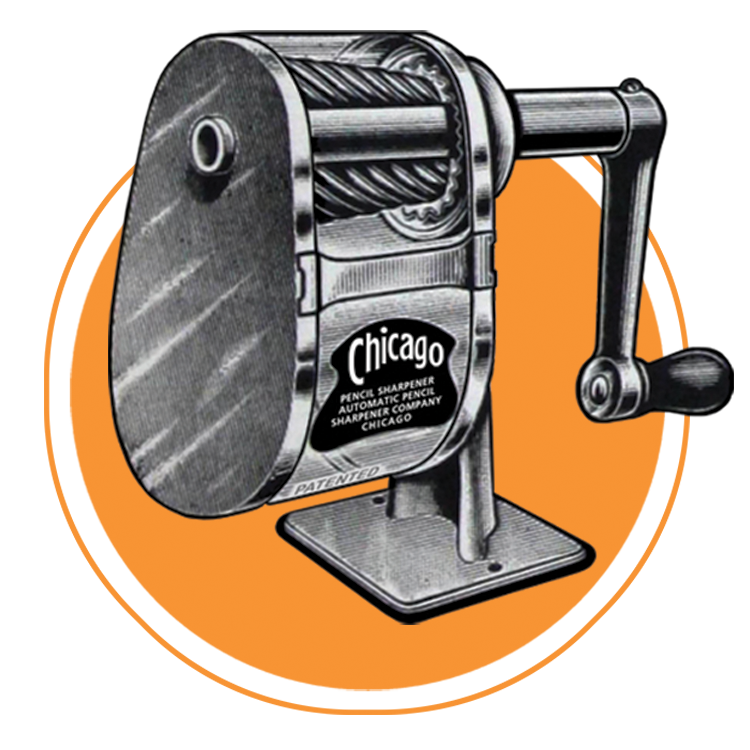
Museum Artifact: Kool-Aid Packet, Raspberry Flavor, c. 1940s
Made By: Perkins Products Company, 5555 W. 65th St., Chicago, IL [Bedford Park]
Donated By: Stephen Kelley
“It takes just one word to solve all your refreshment problems. What’s the easiest home-made drink to make? Kool-Aid! What costs only 5 cents a package, yet is enough to make 10 big, frosty drinks? Kool-Aid! What frozen desserts, frozen suckers, and other icebox treats taste more delicious, more flavorful? Kool-Aid! And what’s your best buy in wholesome refreshment? Kool-Aid!” –Perkins Products advertisement, 1950
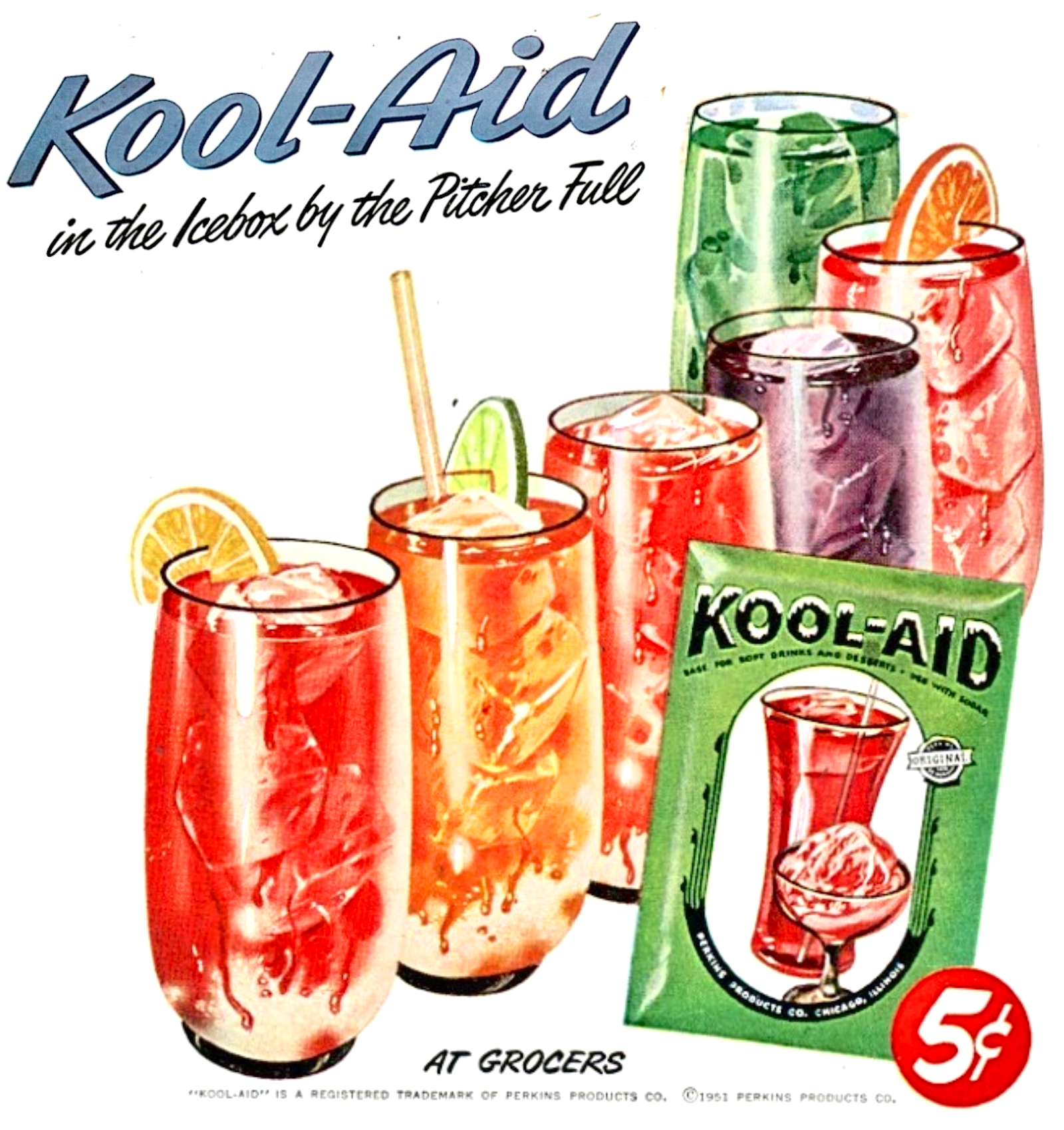 Before the giant, sentient jug known as the “Kool-Aid Man” crashed through his first brick wall and into our hearts, the original mascot of America’s favorite powdered fruit drink was the decidedly less destructive “Kool-Aid Kid,” a blonde-haired, Dennis the Menace style cartoon character who was always—for no apparent reason—clad in German lederhosen. Despite his name, the Kool-Aid Kid did not grow up to become the Kool-Aid Man, unless he was part of an undisclosed 1950s science experiment gone wrong, a la The Fly, in which his DNA was spliced with that of a glass pitcher.
Before the giant, sentient jug known as the “Kool-Aid Man” crashed through his first brick wall and into our hearts, the original mascot of America’s favorite powdered fruit drink was the decidedly less destructive “Kool-Aid Kid,” a blonde-haired, Dennis the Menace style cartoon character who was always—for no apparent reason—clad in German lederhosen. Despite his name, the Kool-Aid Kid did not grow up to become the Kool-Aid Man, unless he was part of an undisclosed 1950s science experiment gone wrong, a la The Fly, in which his DNA was spliced with that of a glass pitcher.
The more practical explanation for the mascot swap from Kid to Man was the sale of the Kool-Aid brand in 1953 from the Chicago-based Perkin Products Company—originators of the famed packet juice—to the super-conglomerate General Foods Corp. of New York, owners of Post cereals, Maxwell House coffee, and Kool-Aid’s biggest influence, Jell-O.
The deal worked out well for everybody. Kool-Aid inventor Edwin Perkins, at 64, was able to enjoy retirement with his wife Kitty, while his old company—reborn as a General Foods subsidiary—was sent on a profitable rocketship by its new president, W. Parlin Lillard, and a notable new advertising agency, the famous firm of Foote, Cone & Belding (FCB).
By 1954, FCB had already ditched Perkins’ old lederhosen kid and introduced the new face of Kool-Aid; a silly, haphazard concept that became one of the unlikely icons of American “fast food” supremacy around the world.
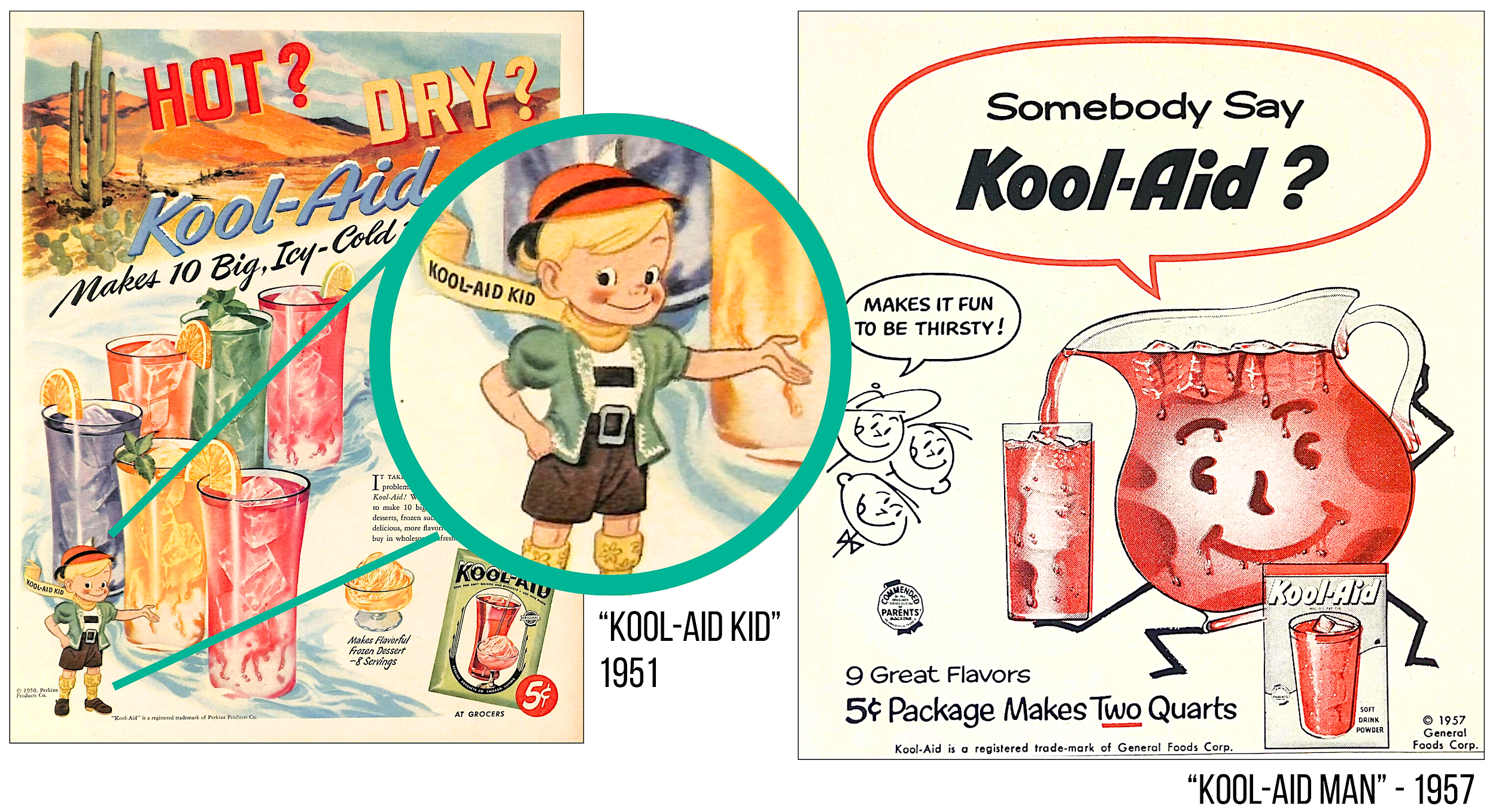
“Kool-Aid was the beneficiary of a lucky break in advertising,” FCB executive and long-time Chicago ad-man Fairfax Cone recalled in his 1969 memoir, With All Its Faults: A Candid Account of Forty Years in Advertising. “This came about when Marvin Potts, [FCB]’s chief art director in Chicago, amused himself at a picture-taking session by drawing with his finger, on a frosty pitcher of purple grape Kool-Aid, a happy, smiling face. Thus is many a great advertising idea come by—by purest chance. . . . Soon the smiling pitcher was the feature of the Kool-Aid package, as well as the printed advertising and each television commercial. Added to the fact that a five-cent package made two full quarts, children found the picture irresistible.”
The explosion of Kool-Aid’s popularity in the 1950s and ‘60s might have obscured its humble Midwestern roots a bit, if not for the lasting enthusiasm of the people of Hastings, Nebraska, where Edwin Perkins first perfected his formula in 1927. The town still celebrates its local hero at the “Kool-Aid Days” festival each year, even though the actual product was only made there for four years. Chicago, by comparison, has largely lost track of its role in the Kool-Aid story, despite being the manufacturing headquarters of the brand for a rather more significant 70 years.
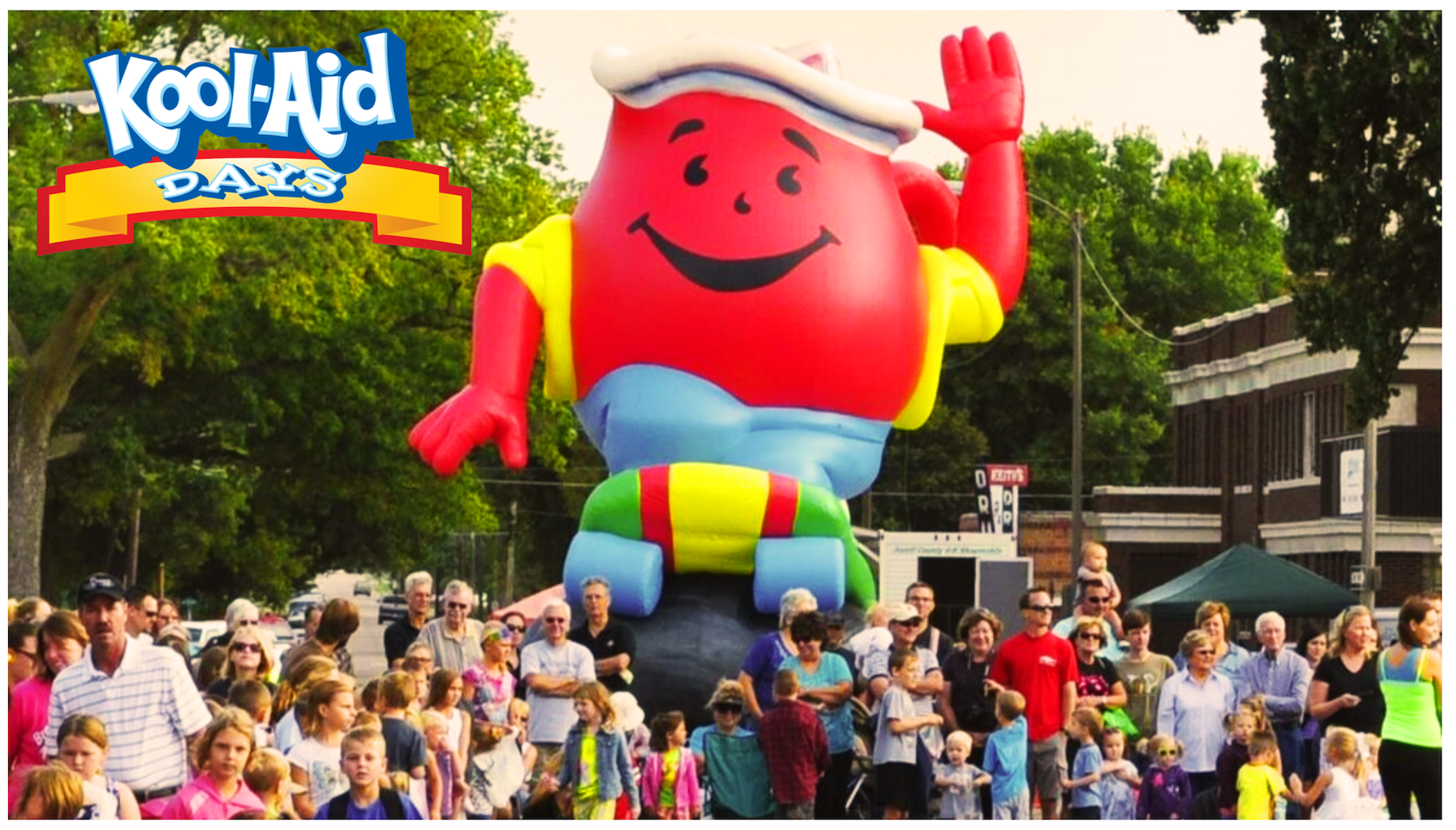
[The Kool-Aid Days festival is held annually in Hastings, Nebraska, where Kool-Aid inventor Edwin Perkins first introduced the product in 1927]
History of Perkin Products & Kool-Aid, Part I: Hendley to Hastings
Edwin Elijah Perkins was born on January 8, 1889, in Lewis, Iowa, the oldest child of farmers David and Kizzie Perkins. When he was four years old, his family relocated to rural Nebraska, near Beaver City in the sparsely populated south-central edge of the state. The pioneer lifestyle—Edwin was part of that generation that really did walk three miles through blizzard conditions to a one-room schoolhouse—certainly developed a lifelong work ethic. It wasn’t until the Perkins family moved a mere eight miles west, though, that Edwin was introduced to the colorful world of 20th century commerce.
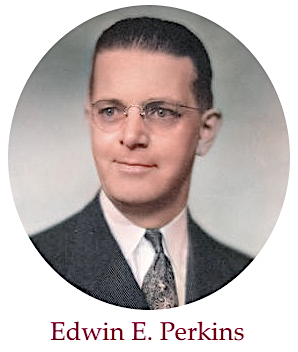 Around 1900, his father David purchased a humble general store in the tiny town of Hendley, Nebraska, pop. 238. The growing family—Edwin eventually had seven siblings—lived in the back of the shop, and everyone pitched in to help run the business.
Around 1900, his father David purchased a humble general store in the tiny town of Hendley, Nebraska, pop. 238. The growing family—Edwin eventually had seven siblings—lived in the back of the shop, and everyone pitched in to help run the business.
As a kid, Edwin soon developed an unrelenting curiosity about the products in the general store; particularly the packaged goods brought in from dealers and manufacturers from far-flung magical locales like Kansas City, St. Louis, and Chicago. The vibrant packaging itself was his first fascination, and in a desire to replicate them, he soon turned himself into an amateur printer, using a small hand press to make labels for the family shop.
Not content to rely on advertising alone, Edwin also took an increasing interest in the “stuff” inside the packages—the various quack medicines, perfumes, and flavor extracts that occupied the general store shelves. He asked for a junior chemistry set from one of those giant Chicago mail order houses, and through his teen years spent countless hours concocting his own potions and additives. The homemade labels he attached to his creations already displayed the name he’d carry with him for the rest of his career: Perkins Products Company.
After graduating from high school in 1905, Edwin seemed destined for a life as the busiest man in Hendley. He became the town postmaster; published a weekly newspaper called the Hendley Delphic; and opened the first local telephone exchange. He even married his high school sweetheart, Kitty Shoemaker, wooing her back to Hendley from a teaching job in Idaho. The goal, it seemed, was to happily remain the big fish in this very specific small pond. Edwin’s ambitious energy, however, wasn’t designed for that sort of regional containment.
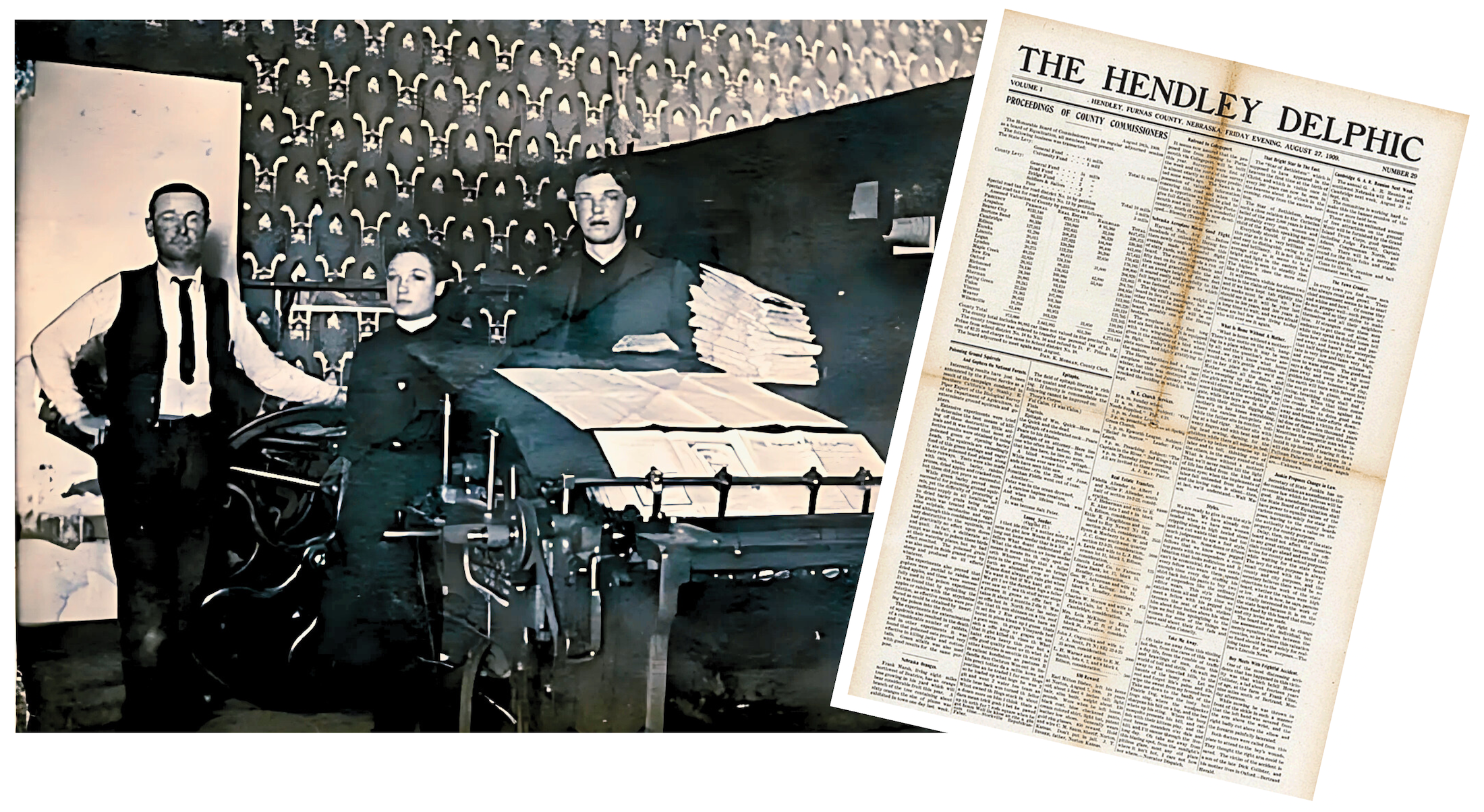
[20-year-old Edwin Perkins, far right, publishing one of the first issues of his self-published local newspaper, the Hendley Delphic, in 1909, with help from staffers Fred and Ada. Courtesy of Hastings Museum.]
By the age of 25, he had established the Perkins Products Company (sometimes known as the Perkins Chemical Company) as a viable mail order business in its own right, combining all his interests by creating, packaging, and marketing his own line of salves, tonics, household cleaners, and hair products.
As was typical for the period, Perkins’ products usually had catchy, hyphenated names designed to look good in stylized type-faces on a lithographed label: Motor-Vigor, Glos-Comb, and Jel-Aid were some of his early best-sellers. Another popular item, called Nix-O-Tine, supposedly helped smokers quit their habit; replacing the nicotine fix with a presumably devastating combination of herbs, chemicals, laxatives, and silver nitrate. Nobody was getting coddled in the 1910s.

Finally, in 1920, Edwin Perkins—along with his wife, parents, and several siblings—relocated from Hendley to the larger town of Hastings, Nebraska, pop. 11,647. The goal was to open up the Perkin Products Company to a bigger audience and network of salesmen, with most of the Perkins family chipping in to run the day-to-day operations at the new factory office. Within two years, the company’s leading product line, known as Onor-Maid, was gaining traction. Edwin and his new chief chemist Orval Adcock were both farm boys with no formal education beyond the age of 16, but they knew their clientele perhaps a bit better than some of the big city manufacturers did.
One of the Onor-Maid products, in particular, emerged as a customer favorite. “Fruit-Smack,” a bottled drink concentrate, was selling faster than Perkins’s door-to-door salesmen could move it. Transporting the product in its original glass bottles was a logistical nightmare, though, and forced Perkins and Adcock back into the lab to hatch a better approach.
As legend has it, Edwin Perkins was heavily inspired by one of the packaged products that had first caught his eye as a kid: JELL-O. If he could sell Fruit Smack in the same manner—as an easily transported powder that could be combined with water—it could become a game-changer.
Perkins was ready to bet on the idea, pouring all his savings into the project and mortgaging his small factory in Hastings. When he couldn’t get a loan from the bank, his parents came to his aid, mortgaging the family home, as well. Finally, in 1927, at the age of 38, Edwin cracked the code, introducing the dehydrated form of Fruit Smack that he renamed . . . Kool-Ade.
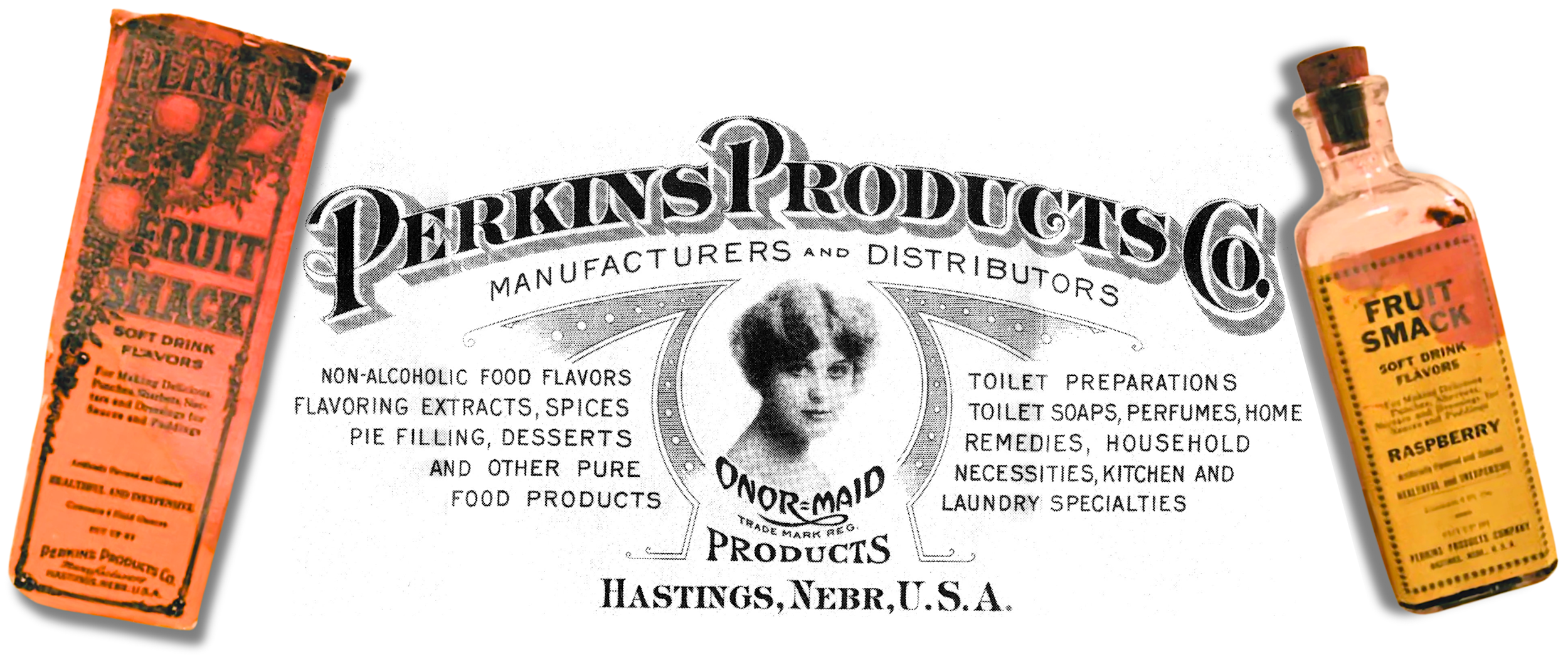
II. Chi-Town Bound
“One of the most recent commodities to be conceived and manufactured in Hastings is ‘Kool-Ade,’ being placed on the market by the Perkins Products Co.,” the Hastings Daily Tribune reported in June of 1929. “Kool-Ade is one of Mr. Perkins’ own inventions, its first appearance last summer, now being marketed all over the country. . . . The rapid growth of sales has necessitated the increase in numbers of employees at the plant on First Street, which is running at top speed to fill the orders.”
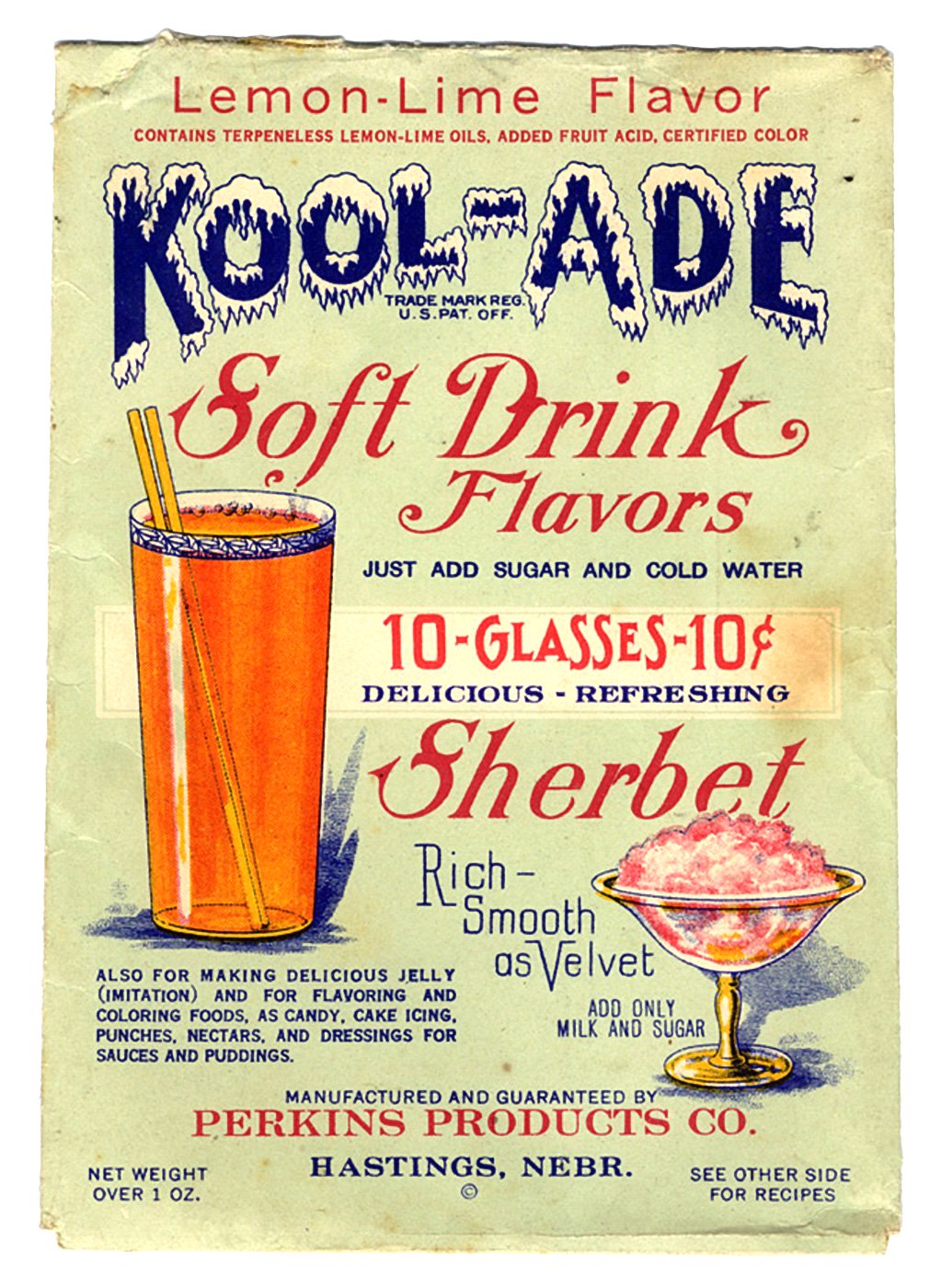 Soon re-introduced under the more familiar spelling of “Kool-Aid,” Perkins’ new flagship product originally sold for 10 cents a packet, and showcased Edwin Perkins’ lifelong love for packaging and presentation, mimicking the brightly colored wax paper envelopes and “six delicious flavors” of Jell-O with some crafty new marketing schemes attached, including shipping boxes that doubled as all-in-one countertop store displays, known as “self-selling silent salesmen.”
Soon re-introduced under the more familiar spelling of “Kool-Aid,” Perkins’ new flagship product originally sold for 10 cents a packet, and showcased Edwin Perkins’ lifelong love for packaging and presentation, mimicking the brightly colored wax paper envelopes and “six delicious flavors” of Jell-O with some crafty new marketing schemes attached, including shipping boxes that doubled as all-in-one countertop store displays, known as “self-selling silent salesmen.”
As curious customers caught on and demand outpaced the limitations of the Hastings plant, Edwin realized he needed a more strategically located hub to support national and international distribution. He formed a partnership with Fred Schmitt, his sales manager in Milwaukee, and on January 1, 1931, Perkins Products Company, now officially incorporated, moved its headquarters to Chicago. Edwin and Kitty made the move along with the business, but most of the rest of the family and employees stayed behind in Hastings, with some production of Perkins’ non-food products also remaining in Nebraska.
With Kool-Aid now his central focus, though, a 42-year-old Edwin somewhat boldly accepted that transplanting himself from the comforts of small town life to the bustle of one of America’s largest cities would be an imperative if he wanted to give his product the best possible chance at success. Chicago clearly offered better access to raw materials, shipping infrastructure, and a wider labor force, and though the timing of the move coincided with the darkest days of the Great Depression, Edwin remained undeterred. He wisely cut the price of Kool-Aid in half, to 5¢ a packet, reasoning that affordable luxury would still appeal to consumers during economic hardship. The gamble paid off. Kool-Aid became a household staple, especially among families looking for inexpensive treats for their children.
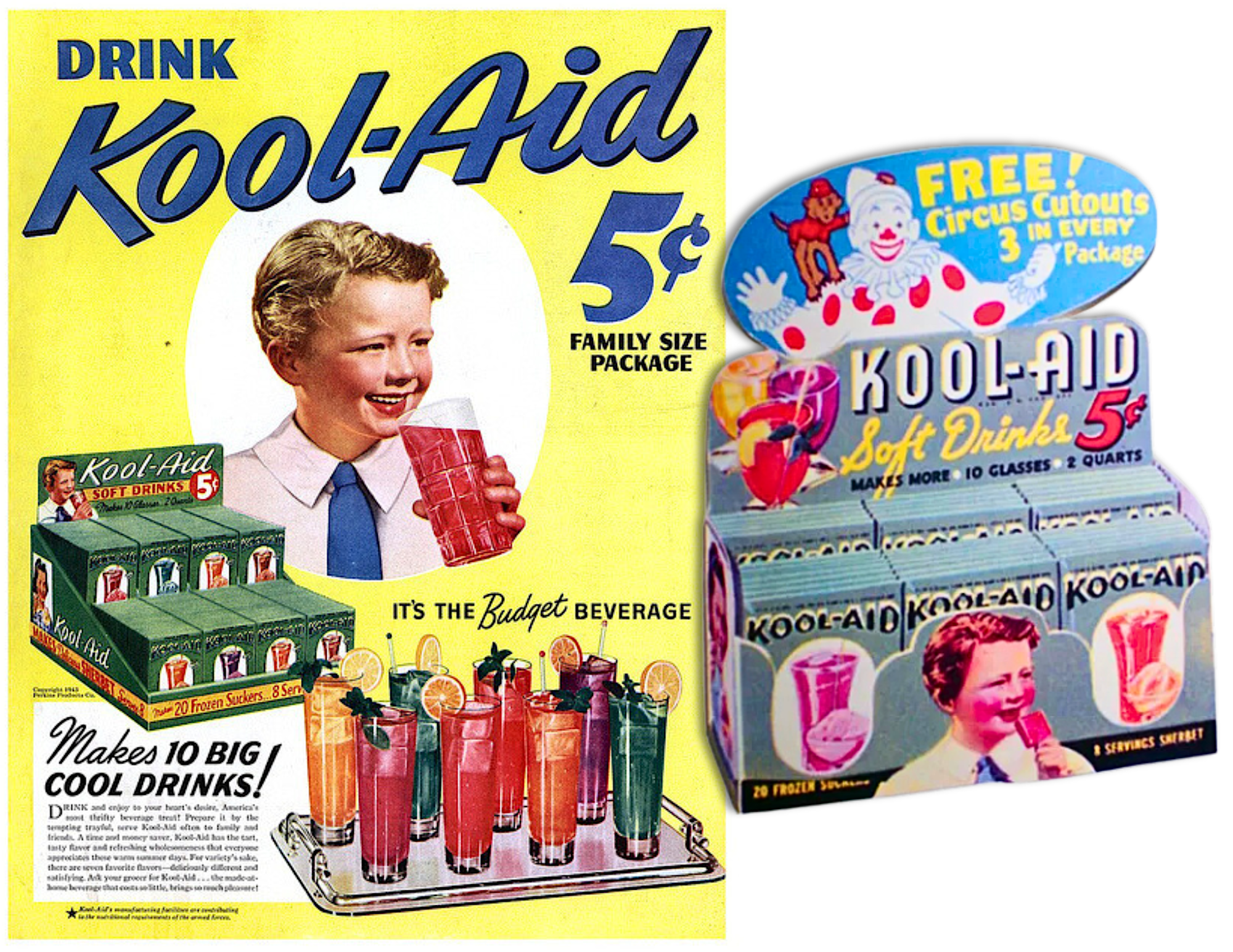
“5 cents makes 10 big, cool glasses!” read a 1937 magazine ad, which dared to suggest some health benefits for good measure. “You will want to serve Kool-Aid often . . . the Sunshine Drink with Vitamin D! This sunshine element in Kool-Aid helps nature build healthy children with strong teeth and sturdy bones. Kool-Aid is truly delicious. There are six fruity flavors—Orange, Lemon-Lime, Grape, Cherry, Raspberry, and Strawberry. When you are hot, tired or thirsty, remember refreshing Kool-Aid . . . colorful, cool and zesty.”
To begin its Chicago era, Perkins Products Company leased a small factory space at 5525 W. 65th Street in the Clearing Industrial District. By 1934, when “Kool-Aid” officially became a registered trademark of Perkins Products, that plant was tripled in space to 33,000 square feet, and it topped 60,000 square feet by 1939, when Edwin Perkins combined the Kool-Aid powder operation with a side business he called the Packit Envelope and Bag Company, which produced all of his Kool-Aid packaging materials.
As described in a 1934 edition of Modern Packaging, the standard Kool-Aid package consisted “of an inside waterproof envelope and an outside printed paper envelope.” Inside the factory on 65th Street, automatic filling units would add the Kool-Aid powder to the first, interior envelope, then send it down a conveyor belt to an automatic sealing machine. “These envelopes are then carried on a conveyor table where they are placed into the outside printed envelopes by hand and fed into the second automatic envelope sealing machine, where the outside envelope is sealed. This complete unit has a production of 120 filled and sealed envelopes per minute.”
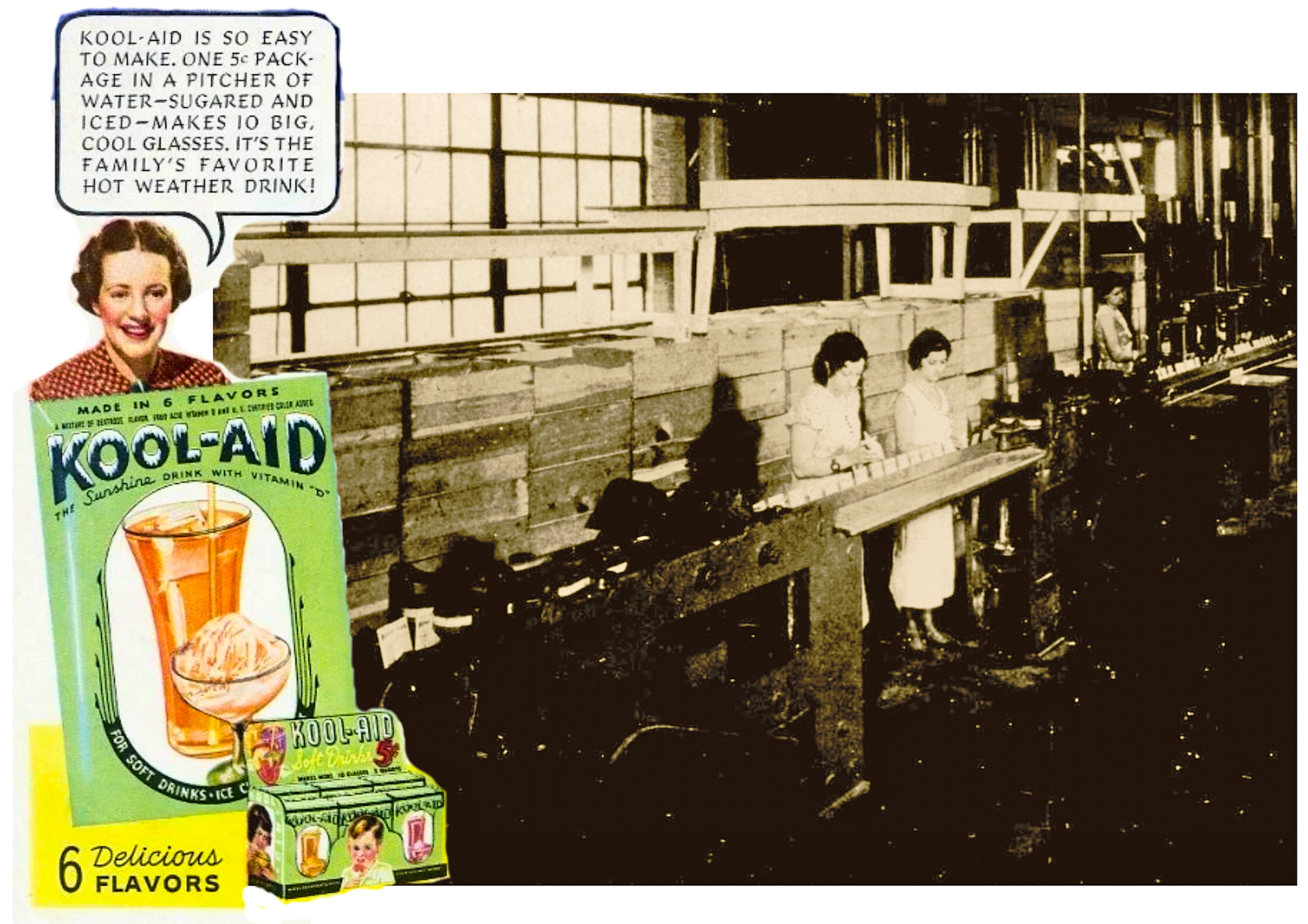
[Left: 1937 advertisement. Right: Women working the packing and sealing line inside the Kool-Aid plant at 5525-5555 W. 65th Street, Chicago, 1934.]
Rather than being intimidated by the “Chicago way” of doing business, Edwin was finally in his element, honing the marketing instincts he’d been developing for decades. He advertised Kool-Aid on national radio shows, roped wholesalers into irresistible distribution schemes, and sponsored a children’s aviation club to capture the imaginations of young customers. He also found ways to make hay outside of Kool-Aid’s prime summertime sales season, by offering sampler packs in the early spring as give-aways that would be free to customers, but still fully redeemable to the retailer.
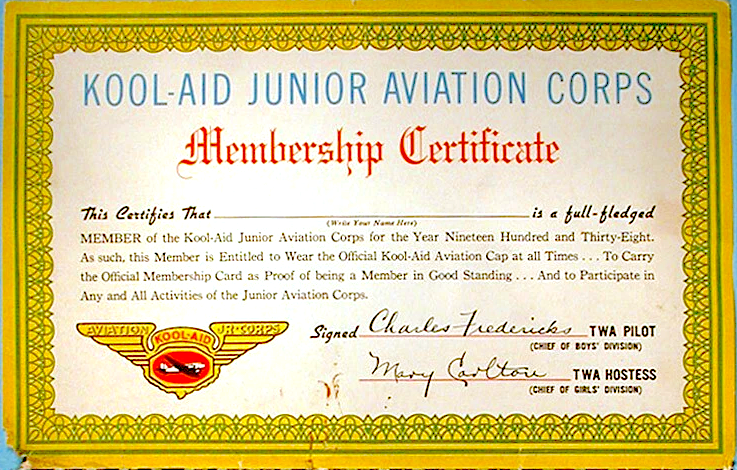 “Perkins Products Co., of Chicago, broke all sales records in March and has continued to break them in April on advertising which will start in June,” Sales Management magazine reported in 1936, noting that “such a statement, on the face of it, may sound a bit impossible,” before explaining the coupon strategy.
“Perkins Products Co., of Chicago, broke all sales records in March and has continued to break them in April on advertising which will start in June,” Sales Management magazine reported in 1936, noting that “such a statement, on the face of it, may sound a bit impossible,” before explaining the coupon strategy.
Perkins even took the unique step in the 1930s of printing Kool-Aid envelopes in Spanish to attract Latin American markets, decades before international branding became a common corporate strategy. In 2025, Kool-Aid’s current parent company, Kraft Foods, estimates that 20-percent of the Kool-Aid market in America is Latino.
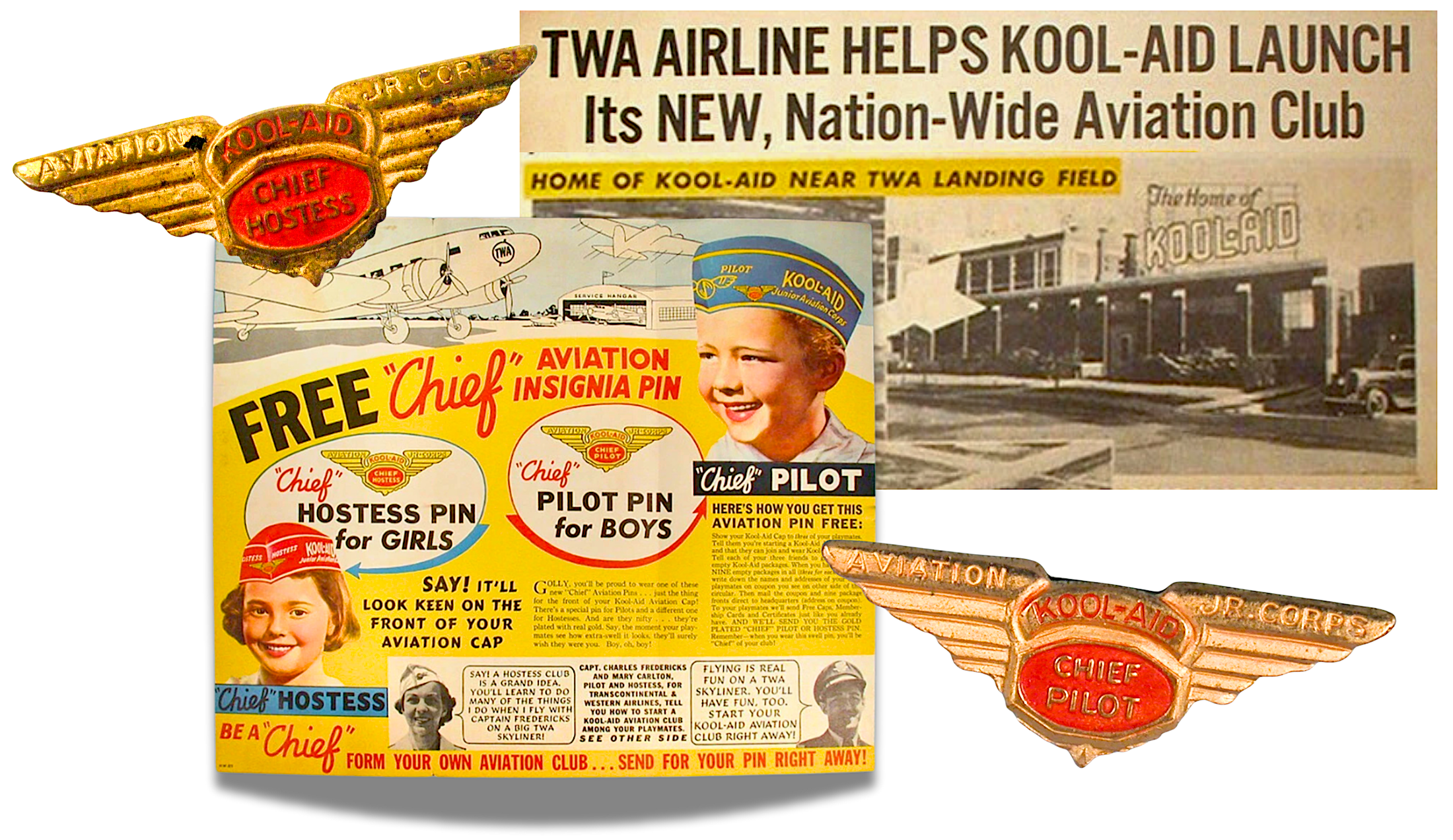
[Pins and promotions from the “Kool-Aid Junior Aviation Corps.” of the 1930s, including a rare glimpse of the exterior of the original Chicago Kool-Aid factory at 5525-5555 W. 65th Street, directly across from what is now Midway Airport and was known at the time as Chicago Municipal Airport]
III. The Conglomeration
“It’s so easy to make … simply dissolve a package of Kool-Aid in 2 quarts water and sweeten to taste. Always chilled and fully blended, it’s the easiest and quickest beverage to serve.” —1951 advertisement
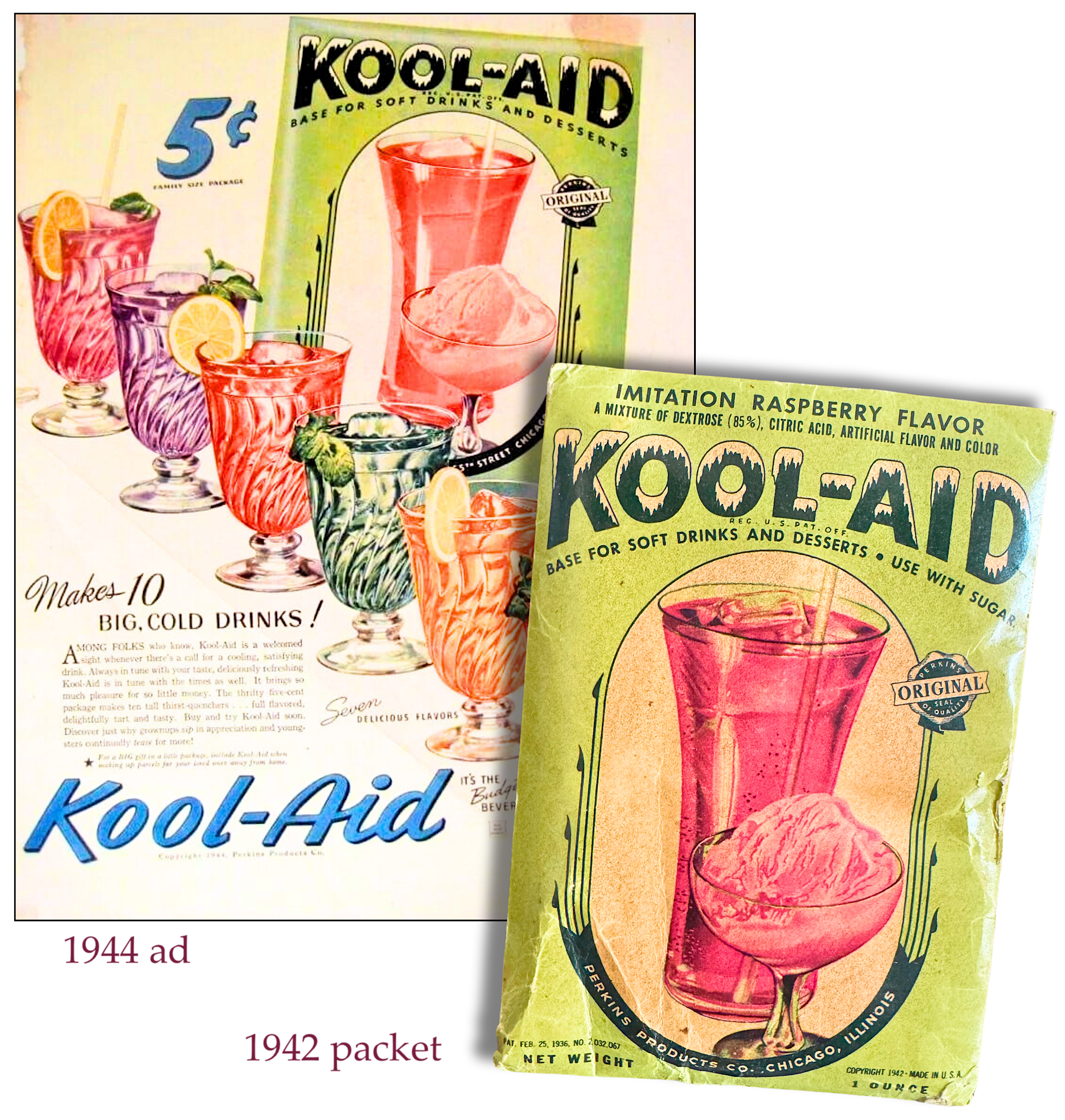 Production slowed a bit at the Chicago plant during World War II, but as evidenced by the “Imitation Raspberry Flavor” packet in our museum collection—dated 1942—Kool-Aid was still quenching thirsts in the early 1940s, and was in fact included in various ration kits sent to soldiers overseas, thanks to its optimal portability. The example packet in our collection was donated by Stephen Kelley, who came upon it many years ago in a rather exciting fashion.
Production slowed a bit at the Chicago plant during World War II, but as evidenced by the “Imitation Raspberry Flavor” packet in our museum collection—dated 1942—Kool-Aid was still quenching thirsts in the early 1940s, and was in fact included in various ration kits sent to soldiers overseas, thanks to its optimal portability. The example packet in our collection was donated by Stephen Kelley, who came upon it many years ago in a rather exciting fashion.
“I found it behind a counter in an old store in Wyoming,” Stephen told us. “The store was abandoned and we stopped to look around. [The Kool-Aid packet] was behind an old counter and I had to use a stick to get it out. That’s why the corners are bent.”
By 1950, the numbers told the story of Kool-Aid’s success. A brand new Chicago factory, located at 7400 S. Rockwell Street in Marquette Park, now employed more than 300 workers and produced over 323 million packets of Kool-Aid annually, generating more than $10 million in net sales—a staggering figure for a product that still retailed at just a nickel.
This is where General Foods Corp. unsurprisingly began showing interest in Perkins’ business, recognizing that most efforts by other companies to replicate or rip-off the Kool-Aid formula had failed. The execs at General Foods respected Edwin Perkins’ accomplishments, but also saw ways they could take his production methods and marketing down more cost-effective and lucrative paths.
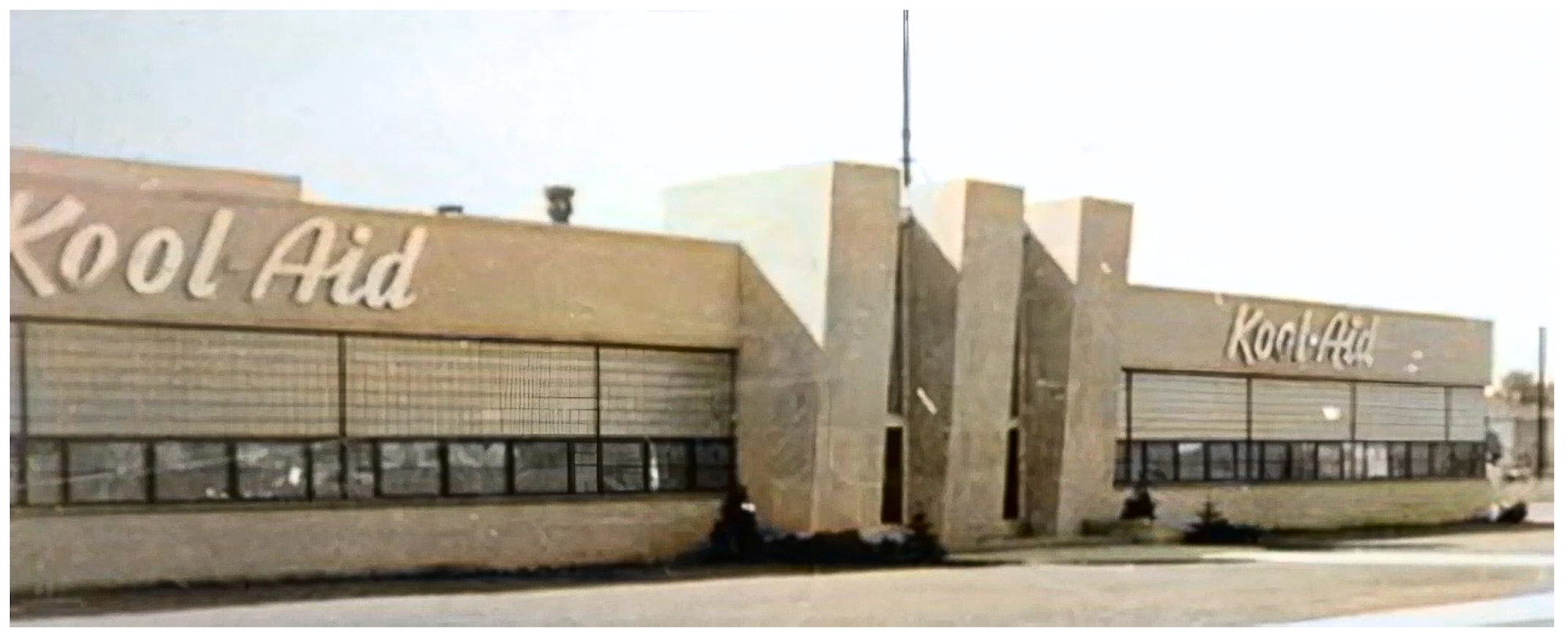
[The Chicago Kool-Aid plant at 7400 S. Rockwell Street in Marquette Park, opened in 1948 and active for over 50 years]
In February of 1953, the deal was done, and the Perkins Products Co. plant in Chicago became another branch of General Foods. Edwin Perkins officially retired that May, and he and Kitty divided their later years between their home in River Forest, IL, and Miami Beach, Florida, with much of their Kool-Aid fortune going to philanthropic foundations in Chicago and good old Hastings College in Nebraska, where their names are still featured on several buildings. Edwin died in 1961 at the age of 72, and Kitty followed in 1977. Their daughter Nancy, born in 1925, died in 1993.
After 30 years, the Perkins era had ended at Kool-Aid, and the conglomerization of the brand had begun, with one of General Foods’ top soldiers, W. Parlin Lillard, put in charge.
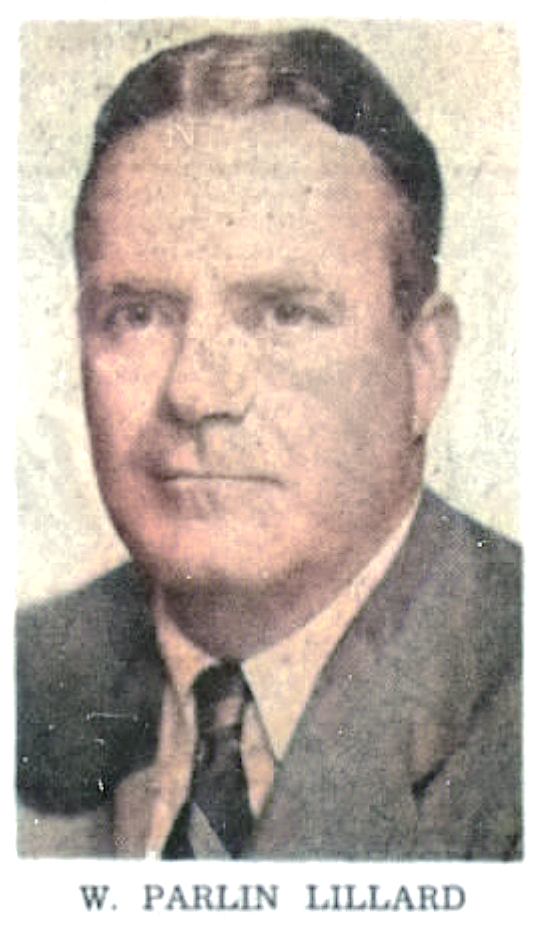 “Prior to the arrival of Lillard on the scene, half the flavor in Kool-Aid went up the factory chimney,” advertising man Fairfax Cone wrote in 1969, adding that he’d never even heard of the Perkins Products Company before General Foods gave him the Kool-Aid account in 1953. “You could smell it for miles around the plant, and it was said that so little taste was left that an adult could only consume the sweet, colored water by intravenous injection.
“Prior to the arrival of Lillard on the scene, half the flavor in Kool-Aid went up the factory chimney,” advertising man Fairfax Cone wrote in 1969, adding that he’d never even heard of the Perkins Products Company before General Foods gave him the Kool-Aid account in 1953. “You could smell it for miles around the plant, and it was said that so little taste was left that an adult could only consume the sweet, colored water by intravenous injection.
“Lillard changed all that. Leaning on his knowledge of General Foods methods, he applied the flavor-sealing process used in the manufacture of Jell-O, and suddenly Kool-Aid had lasting flavor, too. The additional cost was more than made up by a reduction in the amount of powder required to produce the superior drink. Soon, America was drinking Kool-Aid to the extent of thirty-five glasses per year for every man, woman and child in the country.”
IV. Complex Times in Marquette Park
As Lillard, Cone, and the newly introduced Kool-Aid Man helped lead the second wave of Kool-Aid’s national promotional campaign, Chicago remained the central headquarters of the operation, both in terms of the marketing of the business and the manufacture of the product. By the 1970s, General Foods had continued to expand and re-outfit the facility at 7400 S. Rockwell Street in Marquette Park, which included production lines for similar General Foods products like Good Seasons salad dressing, Country Time lemonade, Open Pit BBQ sauce, and Pop Rocks candy. For employees and neighbors alike, the Kool-Aid plant was a happy hub for the community.
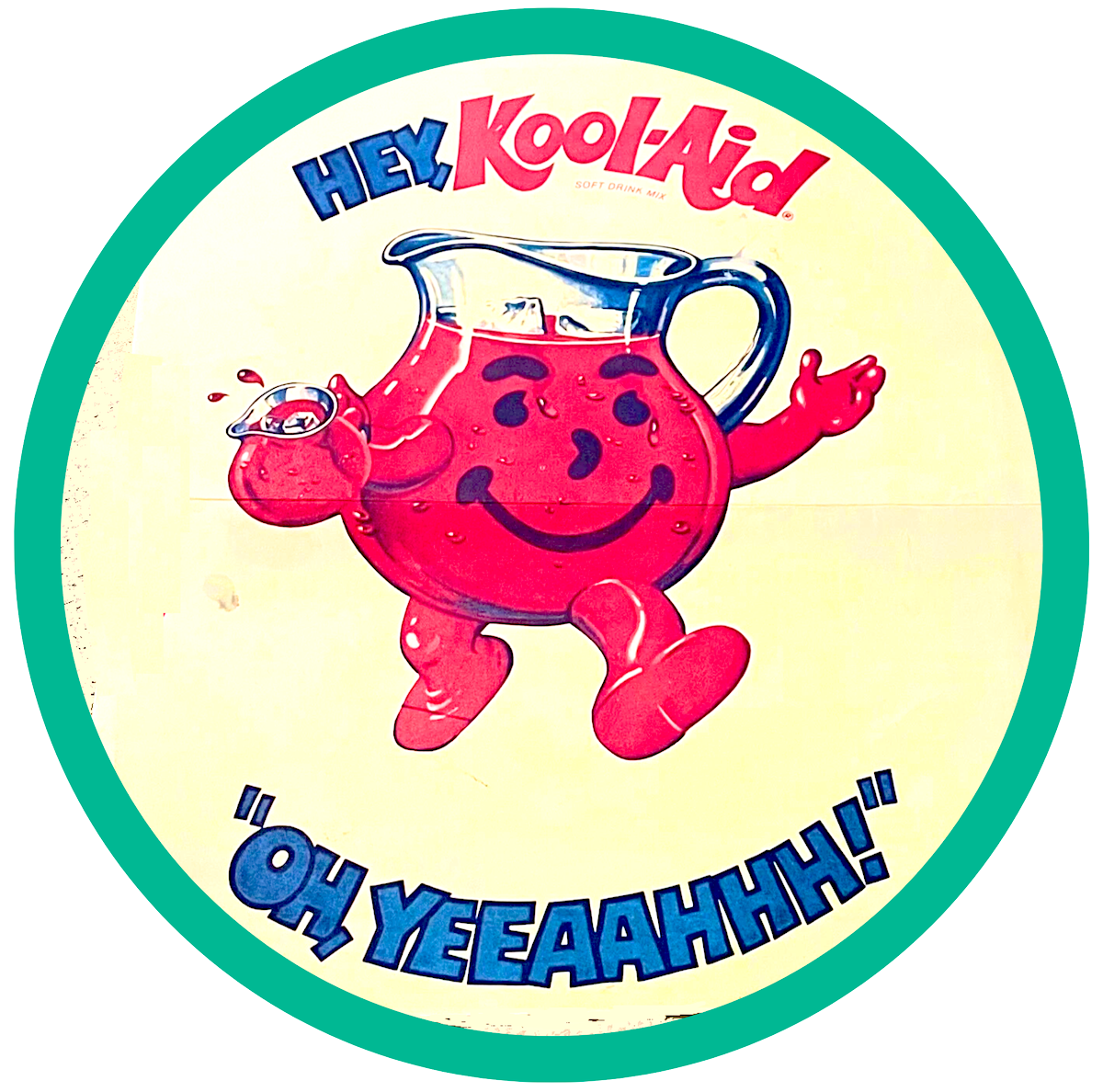 “My mom worked there as the company nurse,” a woman named Lyssa Knizner Skronski wrote in a post on the Forgotten Chicago Facebook group in 2017. “She told us that the drinking fountains had different flavors of Kool-Aid.”
“My mom worked there as the company nurse,” a woman named Lyssa Knizner Skronski wrote in a post on the Forgotten Chicago Facebook group in 2017. “She told us that the drinking fountains had different flavors of Kool-Aid.”
Another former resident of the Marquette Park neighborhood, Ron Skidmore, posted to the Forgotten Chicago group recalling how he and his friends “destroyed the front lawn of [the Kool-Aid plant] playing football in the ’80s. Between Kool-Aid and the Nabisco plant on Kedzie we had the best smelling neighborhood in Chicago.”
Unfortunately, the neighborhood of Marquette Park, which was 95% white in the 1960s, also had a long-running reputation for racial discrimination and violence. When Martin Luther King took part in a peaceful march in the neighborhood in 1966, he and his supporters were pelted with rocks by white supremacists, leading King to state, “I have never seen — even in Mississippi and Alabama — mobs as hostile and as hate-filled as I’ve seen here in Chicago”
In the 1970s, a neo-Nazi organization was headquartered in the same block as the Kool-Aid plant, and its members weren’t against hassling Kool-Aid workers. “There was a drive-in movie theater right behind the factory,” former employee Bob Havlicek recalled to the Vanished Chicagoland Facebook group in 2023. “I was a kid and made Kool-Aid , Country Time Lemonade, and Open Pit BBQ sauce. You couldn’t leave the parking lot without the Nazi brown shirts harassing you to join their Socialist Party. They were a**holes.”
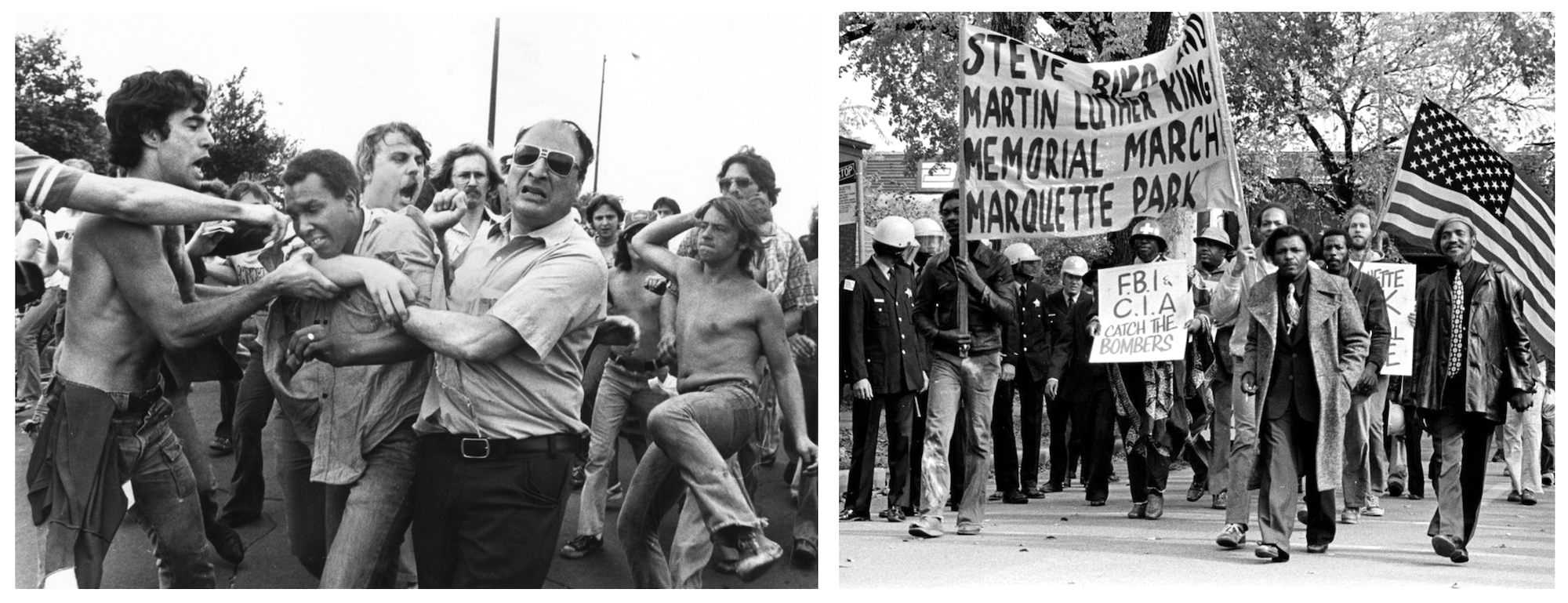
[Left: White supremacists attack a black man during a Neo-Nazi rally in Marquette Park, 1978. Right: Supporters of the late Dr. King’s movement conduct a peaceful protest march in Marquette Park, 1977. Courtesy Chicago Sun-Times collection, Chicago History Museum.]
Kool-Aid got some additional unwanted PR in 1978, when the deaths of 900 “Jonestown” cult members in Guyana was reported to have been caused by the drinking of poisoned Kool-Aid, thus permanently tying the happy summertime drink to the idea of blind cult brainwashing, i.e., “drinking the Kool-Aid.” General Foods reps insisted that the Jonestown victims hadn’t even used actual Kool-Aid, but there was ironically no success in reframing that narrative once it had spread.
As the demographics of Marquette Park began to dramatically change into the 1980s, some of the area’s discriminatory practices diminished, but so did a sense of job security among most of the local factory workers. General Foods had already consolidated its Jell-O production into the Kool-Aid plant to cut costs, and when 200 temporary positions were offered at the Marquette Park building in the fall of 1982, an estimated 4,000 people lined up outside the plant just to pick up an application.
Kool-Aid was still wildly popular and sales were soaring in the ‘80s, but after General Foods was acquired by the tobacco giant Philip Morris in 1985, there were understandable concerns about the fate of the aging plant at 7400 South Rockwell. Eventually, a second major merger with another longtime Chicago business, Kraft, led to the creation of a new parent company for Kool-Aid: Kraft Foods, Inc.
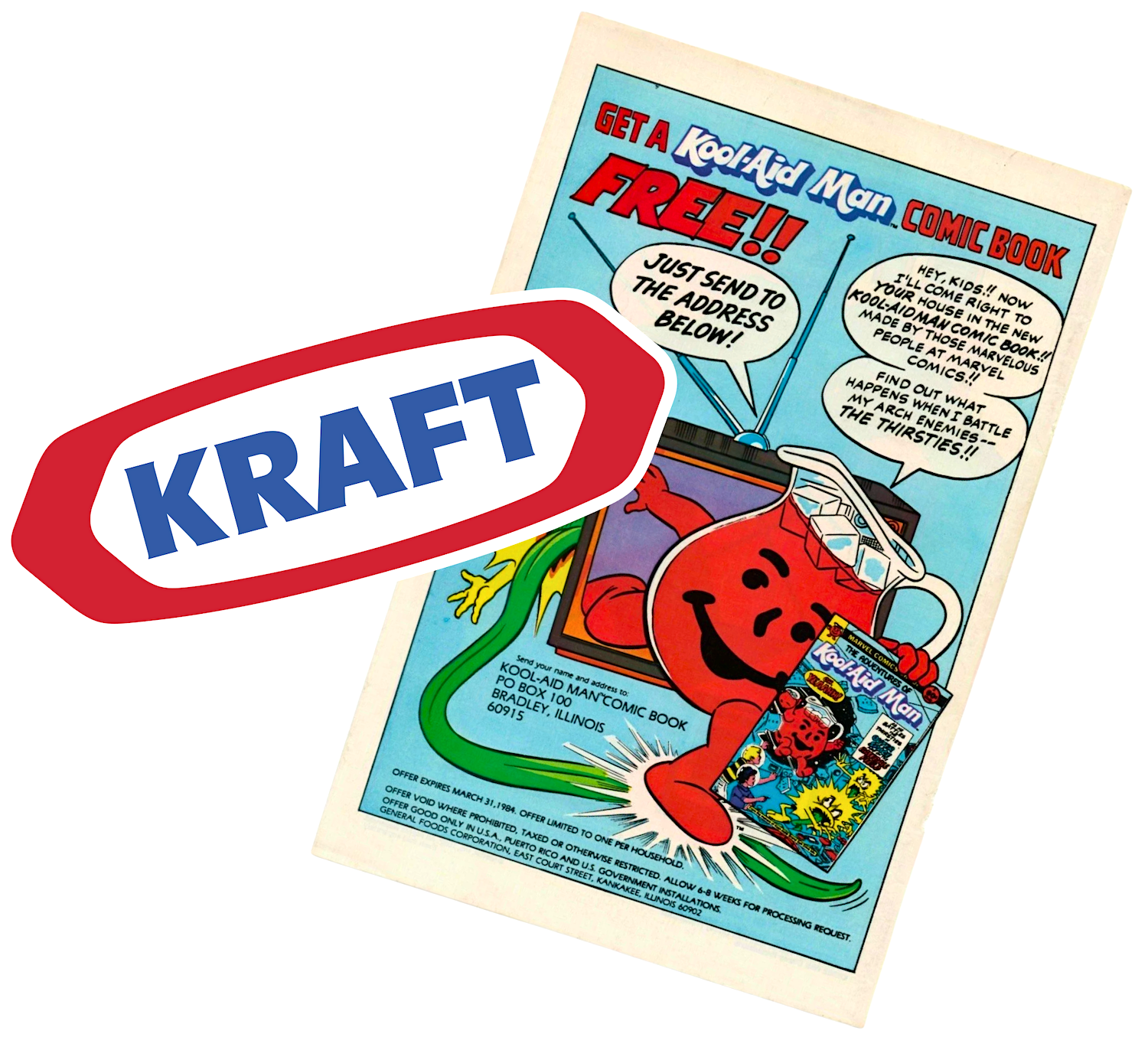 There were approximately 600-700 workers still employed at the Chicago Kool-Aid plant in the early 1990s, when Kraft announced major cuts of its workforce across the city. Kraft, itself, was dominating most of the packaged food categories in America, but its lingering connection to the sinking Philip Morris was cutting into its profits. City and state officials intervened in 1994 to convince Kraft to keep the Kool-Aid plant open, but by 2002, the hammer had come down for good, as 300 remaining workers were let go and the plant was finally shut down after more than 50 years.
There were approximately 600-700 workers still employed at the Chicago Kool-Aid plant in the early 1990s, when Kraft announced major cuts of its workforce across the city. Kraft, itself, was dominating most of the packaged food categories in America, but its lingering connection to the sinking Philip Morris was cutting into its profits. City and state officials intervened in 1994 to convince Kraft to keep the Kool-Aid plant open, but by 2002, the hammer had come down for good, as 300 remaining workers were let go and the plant was finally shut down after more than 50 years.
“The plant relocated to Mexico,” commenter Michael Langer told the Forgotten Chicago group in 2017. “We were there for a month dismantling and removing equipment. A lot of pink powder on things we took out.”
Kool-Aid production ultimately did return from Mexico to the U.S. in 2013, but Kraft set up its new lines in Dover, Delaware, where the 17 current flavors of Edwin Perkins’ powdered drink are now produced, as of 2025.
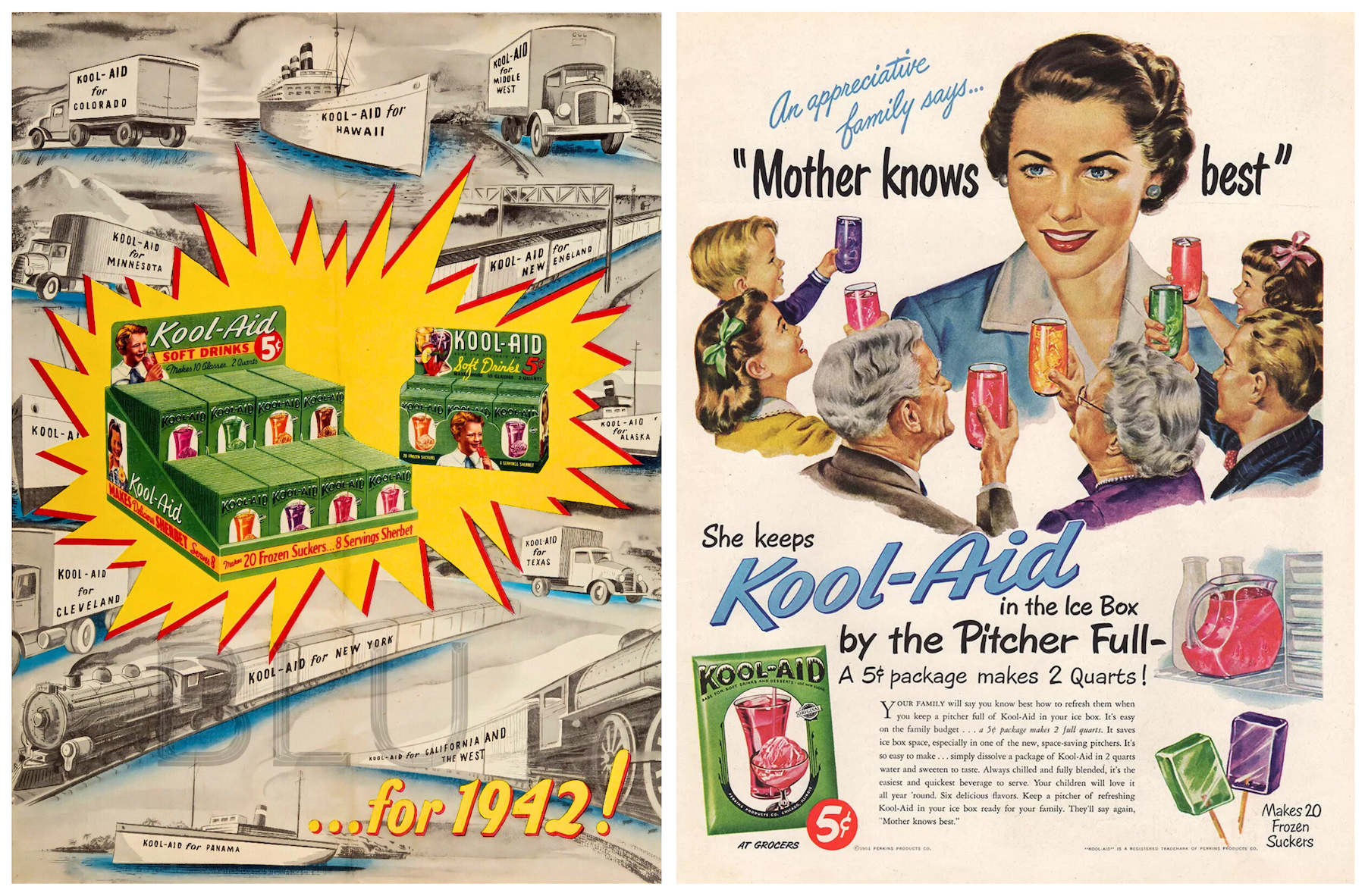
Sources:
Hastings Museum – Hastings, Nebraska
“Make New Drink” – Hastings Daily Tribune, June 27, 1929
“Kool-Aid Turns on Ad Heat as Thirsty Summer Days Approach” – Sales Management, April 20, 1936
“Perkins Products Buys 10-Acre Site, Plans New Building” – Chicago Tribune, Feb 1, 1948
“Strong Sales Efforts Aimed at Leadership” – Sales Management, July 15, 1955
With All Its Faults: A Candid Account of Forty Years in Advertising, by Fairfax M. Cone, 1969
“4,000 Apply” – Journal Gazette & Times Courier (Mattoon, IL), Oct 11, 1982
“Kraft’s Burning Question” – Chicago Tribune, Jan 19, 2000
Profiles of Nationally Distinguished Nebraskans, by E. A. Kral and Jean Sanders, 2010
“Kool-Aid Production Re-locating to U.S.” – fooddive.com, 2012
